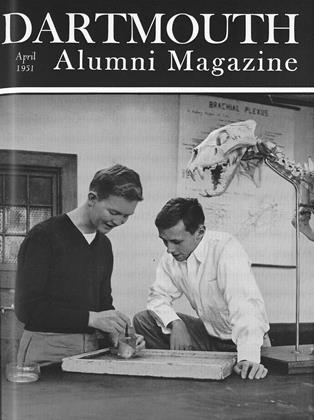Russell Hogin of the American Petroleum Institute, in an article "Life Blood of the World" in the Scientific American of November 1945, pointed out that rock oil, creek oil, Seneca oil or petroleum, had been "discovered" in this country over 300 years before. The Indians had waterproofed their dugouts with it as early as 1542, and it had been in constant use by them as a medicine throughout the sixteenth, seventeenth and eighteenth centuries. Paul Giddens in Pennsylvania Petroleum, 1750-1872 records the first description of petroleum in Pennsylvania as being found in the diaries of a Moravian Missionary in 1768.
The Brewer-Watson property (Hibbard Farm) a mile and a half south of Titusville, Pa., is credited as the birth-place of the petroleum industry, and Colonel Edwin L. Drake as the man who first "struck" oil there in 1859. Dartmouth would be among the foremost in insisting on both credits. The incidents in Hanover in 1853, the four Dartmouth graduates involved, the subsequent developments in the succeeding six years all were essential prerequisites to Colonel Drake's strike on the Brewer-Watson property on August 27, 1859. Petroleum, of necessity, would have been "struck" in some part of the world, at some later date. Where and when no man will ever know. What we do know for a certainty is that the events which transpired on Hanover Plain in 1853 did establish both the place and the date for the birth of the industry.
 View Full Issue
View Full Issue
More From This Issue
-
 Article
ArticleIt All Began in Hanover
April 1951 By FORD H. WHELDEN '25 -
 Article
Article1951 Fund Agents
April 1951 -
 Class Notes
Class Notes1918
April 1951 By ERNEST H. EARLEY, DONALD L. EARR, RICHARD A. HOLTON -
 Class Notes
Class Notes1949
April 1951 By ROBERT H. ZEISER, DAVID S. VOGELS JR., JOHN F. STOCKWELL -
 Class Notes
Class Notes1923
April 1951 By TRUMAN T. METZEL, COLIN C. STEWART 3RD, LEON H. YOUNG JR. -
 Class Notes
Class Notes1911
April 1951 By NATHANIEL G. BURLEIGH, SARGENT F. EATON, MALCOLM G. ROLLINS
Article
-
 Article
ArticleKing Victor Emanuel III Salutes 1917's Cheerleader!
March 1940 -
 Article
ArticleFall Courses
December 1942 -
 Article
ArticleDynamic debating duo
MAY 1984 -
 Article
ArticleFirst Daughter Of the College
December 1951 By A.P. -
 Article
ArticleTHE FACULTY
FEBRUARY 1963 By GEORGE O'CONNELL -
 Article
ArticleJanuary Thaw
JANUARY/FEBRUARY • 1987 By Jack Little '40


